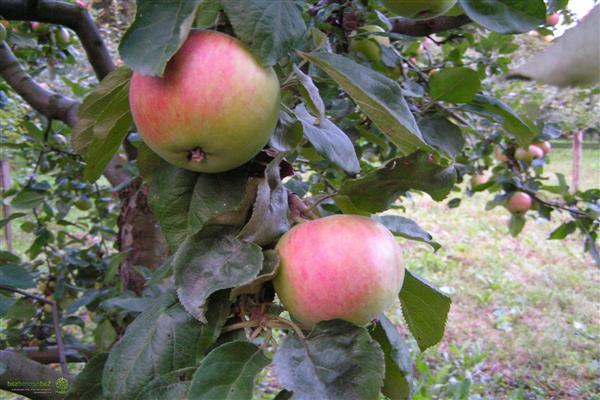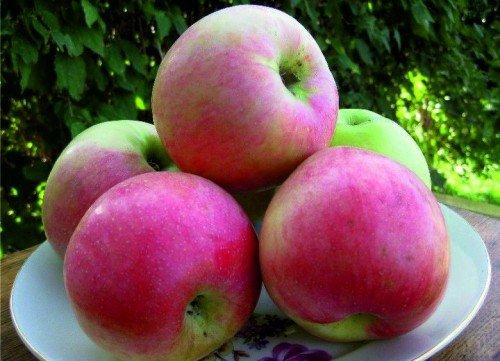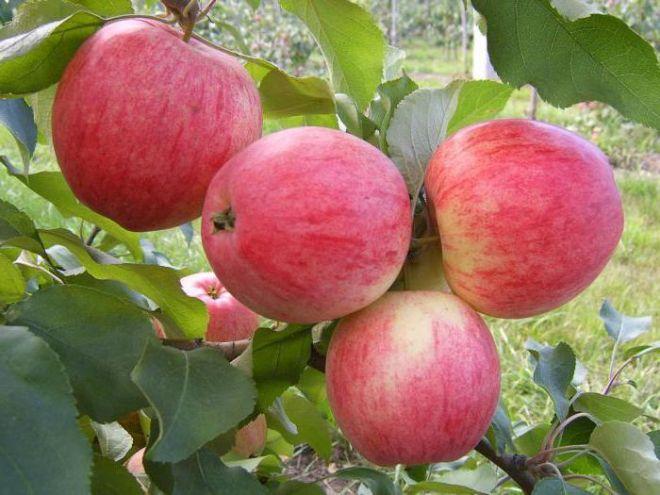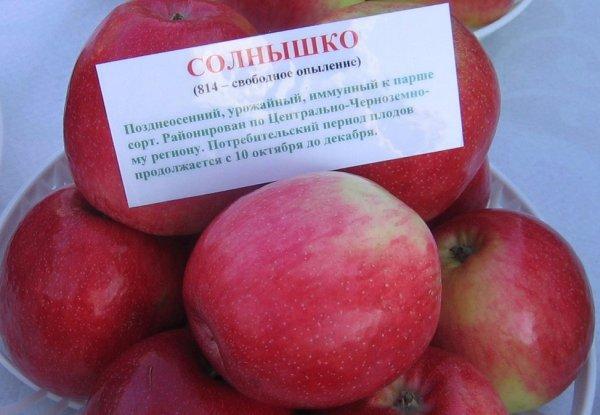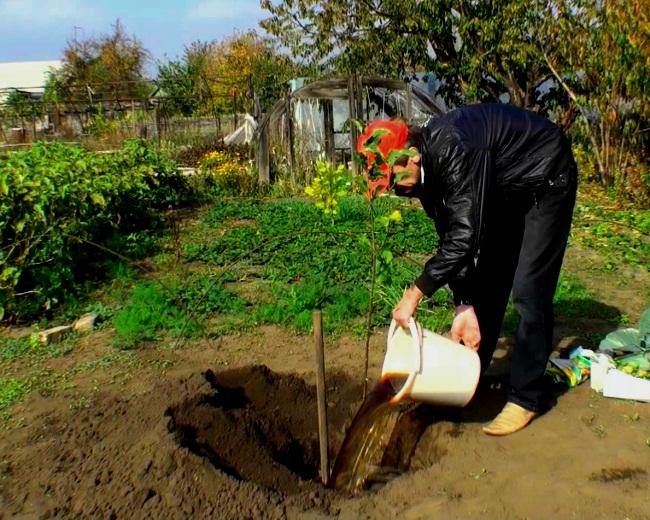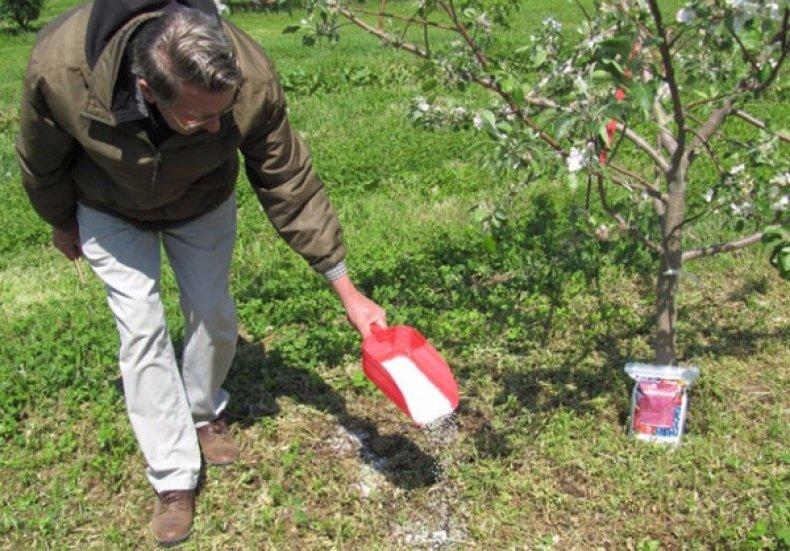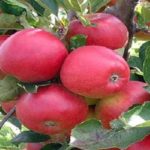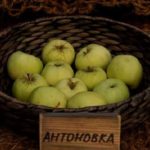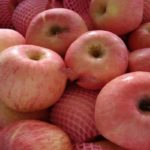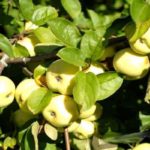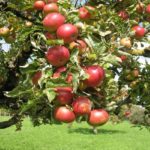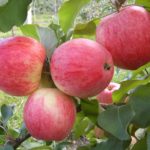Apple tree of the popular variety Sun, late ripening. Amateur gardeners love it and plant it on their plots. Clusters of yellow-red apples look great on the branches of a small tree. To get a high yield, you do not need special care for seedlings. Apple trees are planted not only individually in personal gardens, but also on an industrial scale. The Solnyshko apple tree is included in the register of elite varieties for its beautiful and numerous fruits.
- History of breeding of the Sun apple tree
- Advantages and disadvantages of the variety
- Main characteristics
- External description
- Tree height
- Crown width
- Size and shape of leaves and flowers
- Who is the pollinator variety?
- Precociousness
- Productivity
- Tasting evaluation of fruits
- Frost resistance
- Susceptibility to infections and pests
- Lifespan of a tree
- Ripening and fruiting period
- Start
- Fruit ripening time
- Apple collection and use
- Regularity of fruiting
- Features of growing the variety in the regions
- Planting and caring for seedlings in the garden
- How to choose a healthy seedling
- Landing dates
- Technology and circuits
- Agricultural technology
- Watering and fertilizing
- Pruning and crown formation
- Seasonal processing
- Shelter for the winter
History of breeding of the Sun apple tree
A new generation of apple trees was bred from the seeds of a wild tree in the early 80s by workers of the All-Russian Research Institute - V. Zhdanov and Z. Serova. The young tree, at the end of its sixth year of growth, surprised with a high yield of beautiful and tasty fruits. The new variety has appeared on the farms of many amateur gardeners in Russia.
Advantages and disadvantages of the variety
The Sun variety has positive and negative sides. The benefits include:
- winter hardiness;
- ease of care;
- decorative effect when flowering;
- fruit yield and keeping quality;
- good survival rate of cuttings.
The disadvantages include the timing of harvest, fruit shedding long before ripening in a dry summer or during a season of high humidity.
Main characteristics
The Sunshine apple tree is distinguished by its compactness. In addition to this type of tree, there are dwarf and semi-dwarf varieties; on dwarf rootstocks that grow up to 2 meters in height, they bear fruit after 4 years. The Orlovskoe Solnyshko variety was developed through selection. It has the same characteristics and qualities.
External description
The crown of the tree is round in shape, the branches are spreading - in the fall, under the weight of ripe fruits, they bend towards the ground. In spring they are covered with a cap of purple flowers.
Tree height
The tree grows up to 4 meters in height. The bark on the trunk is dark brown, polished. Branches extend from the trunk in the form of large arcs.
Crown width
Large and small branches diverge by 3.5 meters. The shoots and buds are fleecy, located on short internodes.
Size and shape of leaves and flowers
On short petioles there are ovoid dark green shiny leaves with a sharp curled tip. On dense stalks, 3-5 soft pink buds bloom, which cover the crown with a purple veil.
Who is the pollinator variety?
To pollinate the self-sterile Solnyshka, you will need other varieties of apple trees, such as: Antonovka, Moskovskaya Grushovka, Imrus, Belyi Naliv, Orlik, Mechta, In Memory of a Warrior.
Precociousness
After planting, the tree develops for six years until the first harvest.
Productivity
Gardeners collect about 200 kg of apples from an apple tree, and in horticultural farms it is 100-120 quintals per hectare of plantings.
Tasting evaluation of fruits
The fruit has a sweet taste with pronounced sourness. On a five-point tasting scale, apples receive 4.3 points.
Regarding the chemical composition, 100 g of pulp contains:
- 7.9% sugar;
- 0.86% titratable acid;
- 7.2 mg ascorbic acid;
- 100 mg P-active compounds.
Frost resistance
The variety is not afraid of cold weather - it can withstand frosts down to -40 °. At lower rates, only the upper parts of young shoots and the buds on them are affected.
Susceptibility to infections and pests
The Solnyshko variety has high resistance to scab. Codling moths, mites, and moths cause significant harm, so preventive treatments are required.
Lifespan of a tree
The tree develops and bears fruit from 7 to 35 years. The first harvest is produced at a young age; starting from the age of 30, the yield gradually decreases.
Ripening and fruiting period
Flowers bloom in mid-May. One inflorescence contains 3-6 fleecy buds.The tree produces its first harvest at the end of the sixth year of development.
Start
After pollination, the fruits set, fill and ripen by September.
Fruit ripening time
Full ripening of apples occurs at the end of September, but the full taste is revealed after a month of ripening. Excellent quality and presentation are preserved for 5-6 months.
Apple collection and use
Apple tree fruits are harvested at the end of September, beginning of October. During an unfavorable season, part of the crop is shed before full ripening. Experienced gardeners remove part of the crop to regulate fruit filling; the removed part is used for winter preparations.
Harvest carefully, without touching neighboring branches with apple bunches. The fruits are placed in clean cardboard boxes, covering each row with paper, at a distance from each other. The harvested crop is stored in a cool, dark place at temperatures up to +8 °. If the boxes are placed in the basement for storage, they should not be placed next to the potatoes - this reduces the taste of the apples and shortens the shelf life.
Regularity of fruiting
The apple tree variety bears fruit well, but the yield depends on the amount of ovary, fertilizer applied, and the age of the tree. Experienced gardeners remove some of the flowers on young and old trees in the spring to ensure a regular harvest.
Features of growing the variety in the regions
The Solnyshko variety has been zoned in three regions: the Central and Volga Federal Districts, and the Lower Volga. Characteristics and winter hardiness allow the Sun to develop and bear fruit in the Urals, in the Moscow region, in the Leningrad region. In rainy summers, it is necessary to drain water from the tree trunk.
Planting and caring for seedlings in the garden
A young tree is planted in a permanent place in the fall, a month before frost, or in early spring. The location chosen is sunny, without close groundwater.
How to choose a healthy seedling
A two-year-old seedling is suitable for planting. The root on the seedling should have a good root beard and no damage. The tree trunk is of a uniform color, with shiny bark, without affected areas. Several leaves are kept at the top of the branch. They should be dense, without visible damage from infections and insects.
Landing dates
In the spring, the seedling is planted in early April, before the buds swell, or in the fall, in September-October, before the leaves completely fall off, a month before the cold weather.
Technology and circuits
The pit for planting is prepared in advance, its depth is 60 cm, diameter is 60-80. The top layer is 20 cm, laid on one side, the bottom layer on the other. Broken bricks and wood waste are poured into the bottom of the hole for drainage. The top layer of excavated soil is mixed with rotted manure (3:1), supplemented with ash and mineral fertilizer. The fertilized soil is poured halfway into the hole and left for 2-3 weeks.
Before planting, an apple tree seedling is immersed up to the root collar in water with the addition of 200 ml of manure infusion for 3 hours.
After the root is saturated with water, the seedling is lowered onto a mound formed in the planting hole. A support for tying up the trunk is installed next to the tree, the hole is filled with the remaining soil, and compacted. The scion is placed 4 cm above the soil so that after subsidence it becomes equal to the ground level. The trunk is fixed on a support, the hole is filled with water. Trees are located at a distance of 4-6 meters from each other.
Agricultural technology
To obtain a decent harvest, the seedling requires proper care: watering, loosening the soil, fertilizing, pruning, adjusting the density of the crown and ovary, treating diseases and insects.
Watering and fertilizing
In the hot summer, the tree is regularly watered, and in the rainy season, water is diverted from the tree trunk. A year after planting, in the spring they water with infusion of chicken manure and nitrogen-containing compounds; in the summer, after watering, they add superphosphate and nitroammophoska; in the fall, mineral fertilizers; in the winter, the tree trunk circle is covered with rotted manure.
Pruning and crown formation
The first year the shoot is cut by 1/3 to allow lateral branches to grow. In subsequent years, damaged branches growing inwards are cut out and the crown is formed.
Seasonal processing
Plants are treated against pests and diseases by spraying with a solution of copper sulfate with the addition of infusion of laundry soap and dry mustard powder. After flowering, the apple tree is treated with preparations such as Topaz, Hom.
Shelter for the winter
The Solnyshko variety is winter-hardy, so only young seedlings require covering the trunk circle with rotted manure with a layer height of 15 cm and spraying the crown with a superphosphate solution (30 g per 1 liter of water).


